|
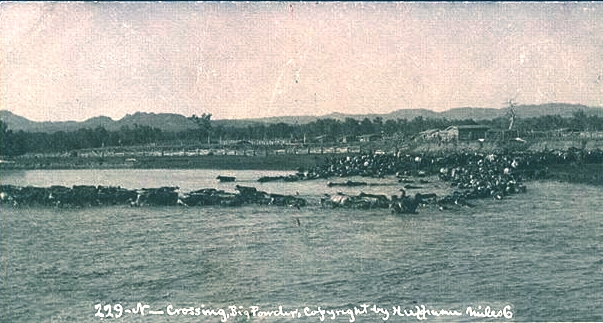
An N Bar herd crossing Powder River, 1886, photo by
Laton Alton Huffman.
The N Bar was a brand owned by E. S. "Zeke" and Henry H. J. Newman's Niobrara
Land and Cattle Company. The company started in Texas and in 1878 trailed 10-15,000 head
to Nebraska. In 1882, the Company trailed 12,000 head to Powder River. The
Company failed as a result of the winter of 1886-1887.
Powder River has been described as being "a mile wide and an inch deep." Yet because of the
war cry of cowboys, picked up by American troops, "Powder River, Let 'er Buck," the river has a fame
well beyond its size. According to Lander cattleman, Edward J. Farlow (1861-1951), author of
Powder River, Let 'er Buck (Annals of Wyoming, Vol 11, No. 1, 1939) and Wind River Adventures: My Life in Frontier Wyoming,
the expression originated with a cattle drive along Powder River to Casper:
Some hands trailing cows to the railroad at Casper in the autumn of 1893 bedded down near the
headwaters of Powder river, near the present Hiland, Wyoming, one night. They
talked about crossing Powder River repeatedly the next morning, and spoke of
getting their swimming horses. The next morning one cowboy, Missouri Bill
Shultz, changed horses to get a good swimmer. Making thir various
crossings, they discovered that in the fall at that place, Powder River was just deep enought to wet a
horse's hoof, and had barely enough energy to trickle from one hole to another.
When they got to Casper, Missouri Bill toasted the hands like this: "Boys, come and
have a drink on me. I've crossed Powder River" They had the drinks, then a few more
and were getting pretty sociable. When Missouri Bill again ordered he said to the
boys, "Have another drink on me, I've swum Powder River," this time with a
distinct emphasis on the words Powder River. "Yes, sir, by God, Powder
River," with a little stronger emphasis. when the drinks were all set up he said, "Well,
here's to Powder River, let 'er Buck!"
Soon he grew louder and was heard to say, "Powder River is coming upeeyeeep! --
Yes sir, Powder River is rising," and soon after with a yip and a yell, he pulls out
his old six-gun and throwed a few shots through the ceiling and yelled, "Powder
River is up, come an' have 'nother drink." Bang! Bang! "Yeow, I'm a wolf and it's
my night to howl. Powder River is out of 'er banks. I'm wild and woolly and full
o' fleas and never been curried below the knees!"
Bill was loaded for bear, and that is the first time I ever heard the
slogan, and from there it went around the world.
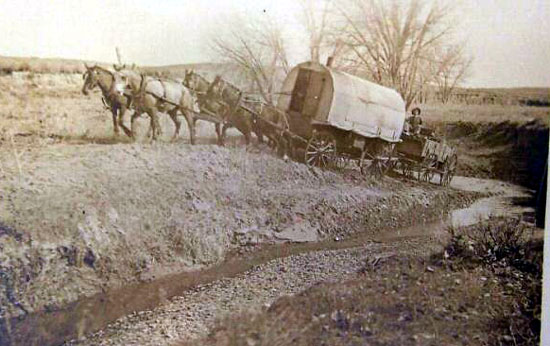
Fording Powder River.
According to Fred L. Beger, writing in The Stars and Stripes, January 31, 1919, the war cry of cowboys was picked
up by American troops during World War I from the Montana National Guard.
The war cry has been used by the University of Wyoming since at least the 1930's when the expression was used
in Lorna Kooi Simpson's Come On, Wyoming:
Come On, Wyoming
Come on, Wyoming, you've got to fight today.
For we want a victory.
Come on, Wyoming, you've got to win today,
for the university.
Come on, Wyoming, we all depend on you;
We are loyal through and through
Powder river, let're buck, let'er buck, Wyoming!!
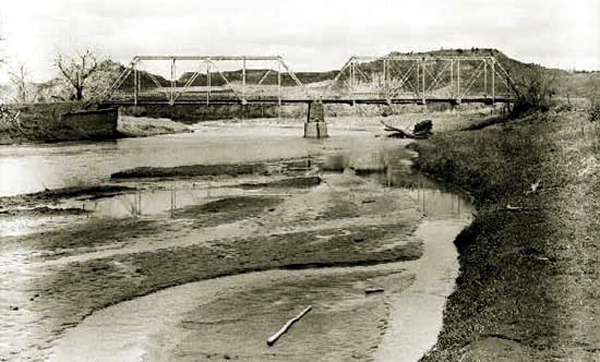
Powder River, near Leiter, Sheridan County, Wyoming
[Writer's note: The name Powder River is used without the definite article "the." Indeed,
noted Colorado historian Hebert O. Brayer has been critized for referring to
the waterway as "the Powder River."]
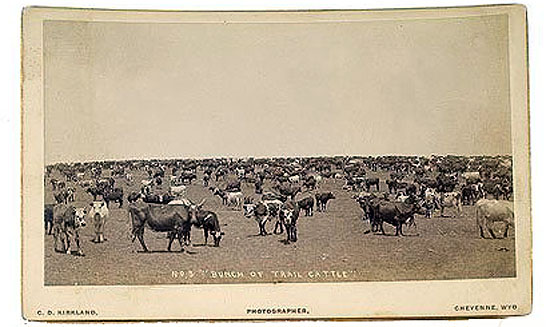
Wyoming Trail Herd, 1880's. Photo by C. D. Kirkland
Nevertheless, like a caravan, the herd would proceed at a rate of about ten miles a day from Texas northward to Nebraska,
Wyoming, and Montana. And as it proceeded further to the north, the more likely it was
to run into the thunderstorms of the great plains and the possibilities of a stampede.
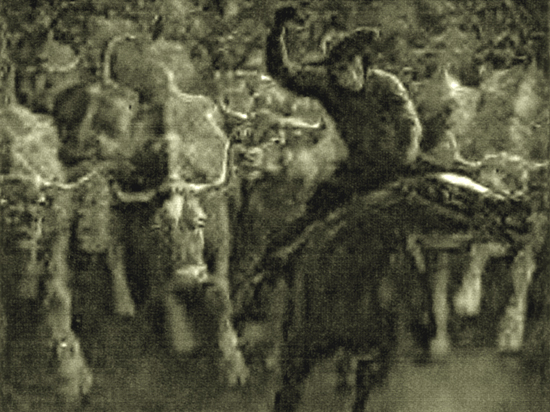
Stampede, portion of engraving by E. Boyd Smith.
Next page: Stampedes.
|